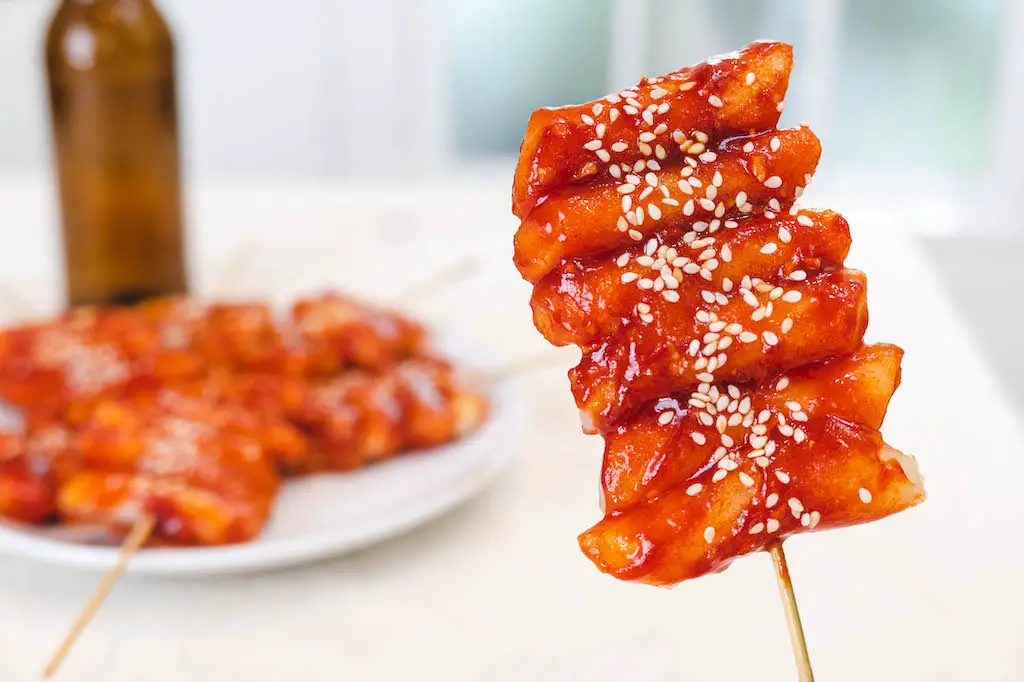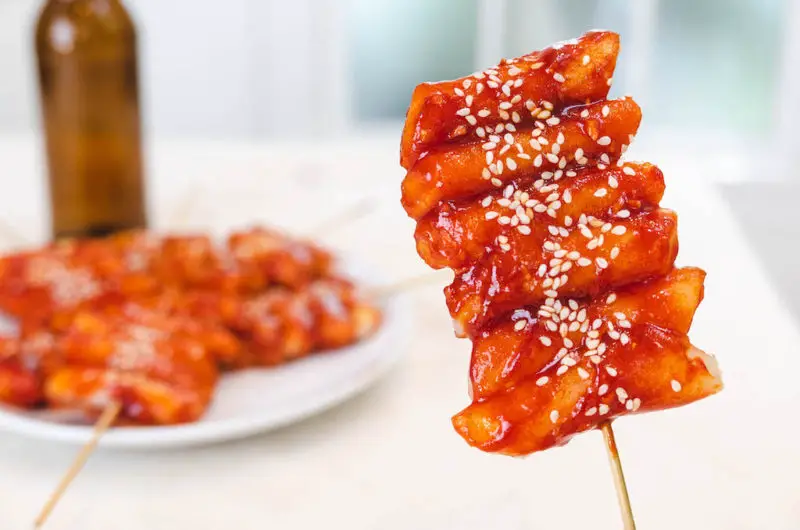This post may contain affiliate links. Please read my disclosure for details at the bottom of this page. As an Amazon Associate, I earn from qualifying purchases on this post about Tteokkochi (Korean Rice Cake Skewers).
Do you enjoy eating Korean street food? If so, which is your favorite? For me, I love eating the deliciously crunchy and chewy tteokkochi–Otherwise known as Korean rice cake skewers.
Tteokkochi is the perfect treat to eat as you wander the streets of Seoul. Not only do you get to taste the classic Korean spicy and sweet flavors, but you can also eat it easily as finger food! Thankfully, this South Korean street treat is incredibly easy to make at home. Soon, you will be adding it to your rotation of fun and unique foods to make throughout the year!
What is Tteokkochi (떡꼬치)?
If you like Korean food, you have probably heard of tteokbokki (Korean stir-fried rice cakes). But, have you ever heard of tteokkochi?
Tteokkochi is an incredibly popular Korean street food made by placing rice cakes on skewers. Then, you either grill or pan fry the skewers until the tteok (Korean rice cakes) are chewy in the center and crunchy on the exterior. Finally, after grilling or pan-frying the rice cakes, you coat them in a slightly sweet and spicy gochujang based-sauce.
These skewers are easy to eat as you walk around, hence why they are such a popular street food!
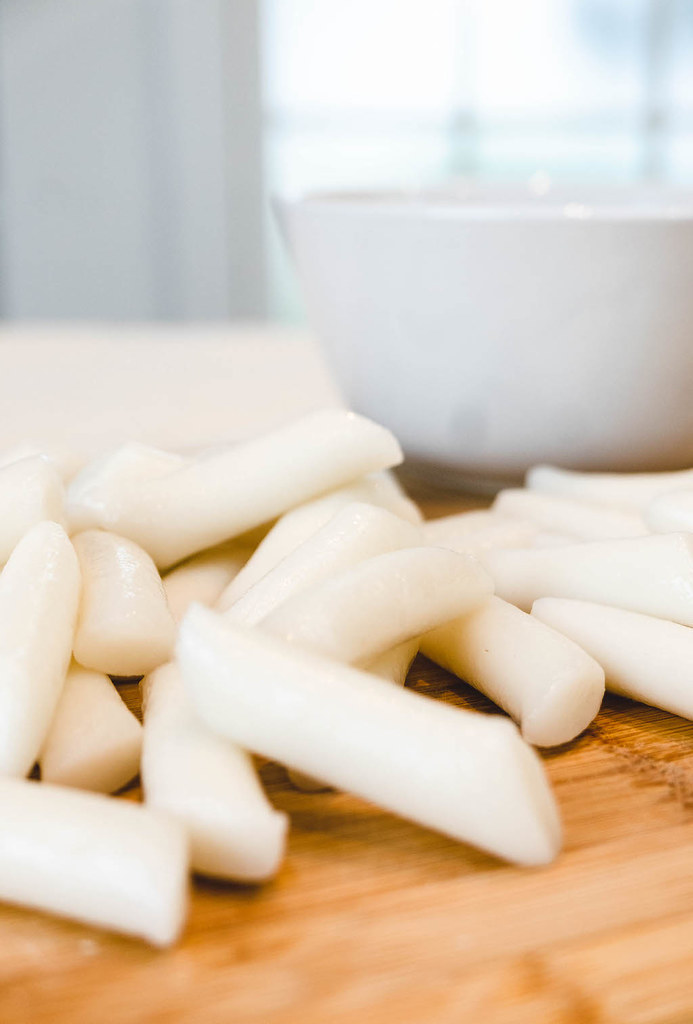
Tteokbokki vs Tteokkochi: What Is the Difference?
Now that you know about tteokkochi, you may want to know about the difference between tteokbokki and tteokkochi.
Tteokbokki (떡볶이): is a Korean stir fry rice cake dish made by cooking the rice cakes in a deliciously thick spicy and sweet gochujang-based sauce. Often, you add other ingredients with the rice cakes and sauce. For example, you can use ingredients such as hard-boiled eggs, eomuk (Korean fish cakes), and scallions. Once you finish cooking this dish, the rice cakes are soft and chewy. After all, they are simmered for a while in the thick and soupy base. In restaurants, tteokbokki is usually served in a bowl or plate to share amongst the table. When eating at a street vendor, tteokbokki is often served in individual cups.
Tteokkochi (떡꼬치): While the rice cakes sit in a thick sauce with tteokbokki, they are placed on skewers, grilled, and then coated with a sauce with tteokkochi. These rice cakes have a crunchy exterior from the grilling method. Also, unlike tteokbokki, you use your hands to hold and eat this skewer dish!
So, while both dishes use the cylinder Korean rice cakes and a sauce made from gochujang, the texture and taste are very different because of the difference in ingredients and cooking methods.
Now that we know about Korean rice cake skewers and the difference between tteokbokki and tteokkochi, let’s learn some cooking tips and tricks!
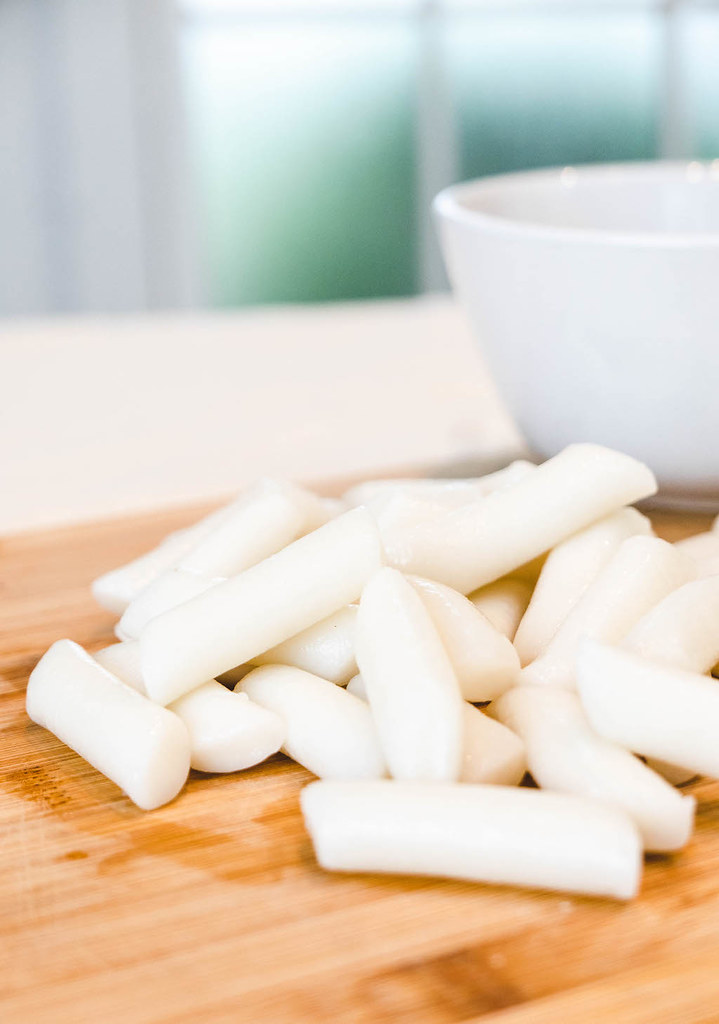
Tteokkochi Cooking Tips and Tricks:
- When using anything wooden in an oven, or on a grill or stovetop, I recommend soaking it first. That way, your wooden object does not char or burn. For example, always soak a wooden plank when cooking fish. That way, you can use the plank more than once and it won’t char. In this case, I recommend soaking the skewers before pan-frying. This way, it will be easier to remove the tteok and the skewers won’t burn! Soak the skewers 10-to-15 minutes before grilling to prevent them from burning.
- You can cook the rice cakes using three different methods: grilling, pan-frying, or deep frying. While you can choose your preferred method, I think grilling or pan-frying tastes just as delicious as deep frying without the mess and excess oil.
- If your rice cakes are the chilled or frozen pre-packaged versions, make sure to blanch them in boiling water first. Then, rinse them with cold water and drain them before placing them on the skewers. This way, your tteok will have a soft chewy texture. Otherwise, they will have a hard and dense consistency.
- Once you blanch the tteok, they will become very sticky. If you need to, use plastic gloves to place them on the skewers.
- If you buy freshly made tteok, you do not need to blanch them. Fresh tteok is soft enough to use!
- Leave enough room on your skewers to hold it without getting your hands sticky. While we all want a lot of tteok on our skewers, if you add too many, it becomes less ‘finger food’ friendly!
- When adding the sauce to the skewers, you can either use a basting brush or dip them into a bowl of the sauce. Whichever you decide, these skewers will taste deliciously the same! Below, we listed some items you may need to make these skewers. As an Amazon Associate, these links are part of the affiliate program.
- Serve with beer or soju for the perfect drinking snack!
Korean Rice Cake Skewers Frequently Asked Questions:
Below, we listed some questions you may have about this tteokkochi recipe. If we do not answer your question, feel free to leave a comment or email us at [email protected]!
What Does Tteok Taste Like?
If you have never tried tteok (Korean rice cakes), you will be surprised by the taste and texture!
Honestly, tteok does not have much taste on its own. It has a nice, clean, and mild rice flavor. After all, tteok is made from rice! While it doesn’t have much flavor on its own, tteok takes on the flavors of what it is cooked with! So, make sure your sauces and condiments taste delicious when cooking with these Korean rice cakes!
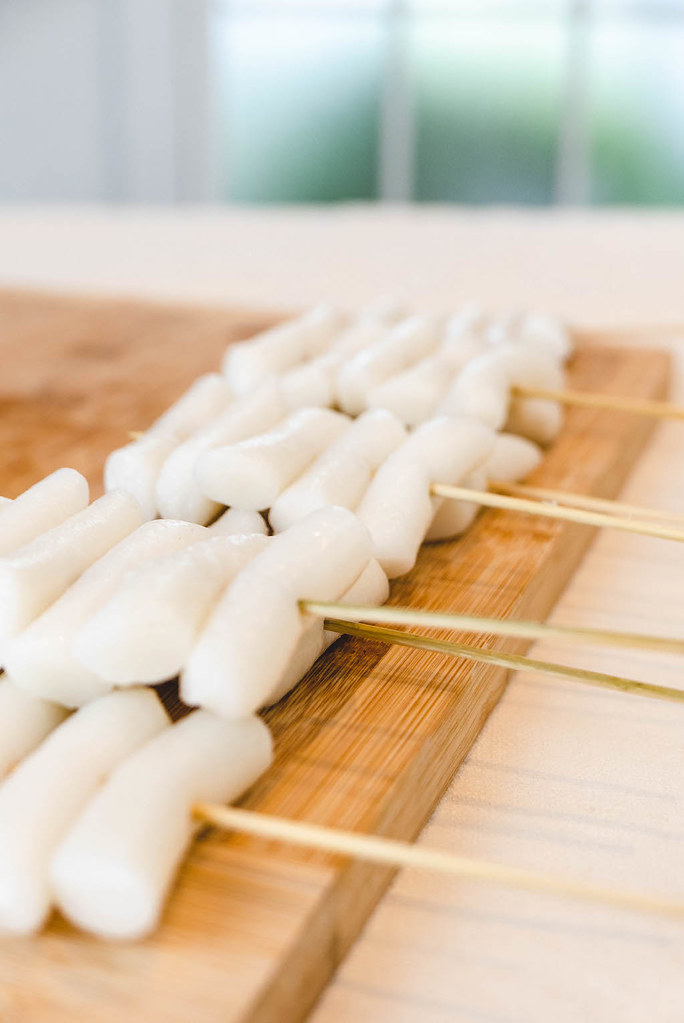
Now, the texture is completely different than anything we have in the United States or Europe. The most comparable Western dish would be potato gnocchi from Italy. Another good comparison is Japanese mochi–Tteok has the same texture as the outside sticky part of the Japanese dessert. So, if you like that sticky texture of mochi, you will like Korean rice cakes!
Can You Make These Allergen Friendly? (Gluten-Free, Soy-Free, Etc.)
Yes! You can make this tteokkochi recipe allergen-free. If you want to make them allergen-free, you need to buy specific ingredients.
- Tteok (Korean Rice Cakes): While tteok are known as Korean rice cakes, they often contain wheat. When buying rice cakes, make sure to buy versions made of 100% rice. My favorite brand is Our Home. While difficult to find online, you can find the brand in many Asian grocery stores. Otherwise, tteok is free of other major allergens.
- Gochujang: Often, gochujang contains major allergens such as gluten or soy. Thankfully, these days, there are allergen-free options available on the market. If you need gluten-free or soy-free brands, check out our ‘Gluten-Free Gochujang Brands’ blog post! There, you can also find gluten-free and soy-free brands as well as kosher brands.
- Soy Sauce: Like gochujang, soy sauce contains major allergens such as gluten and soy. Thankfully, there are also allergen-free options on the market! Look for our favorite gluten-free and soy-free brands of soy sauce in our blog post ‘Gluten-Free Soy Sauce Brands.’ There, you can find items such as gluten-free tamari and soy-free coconut aminos.
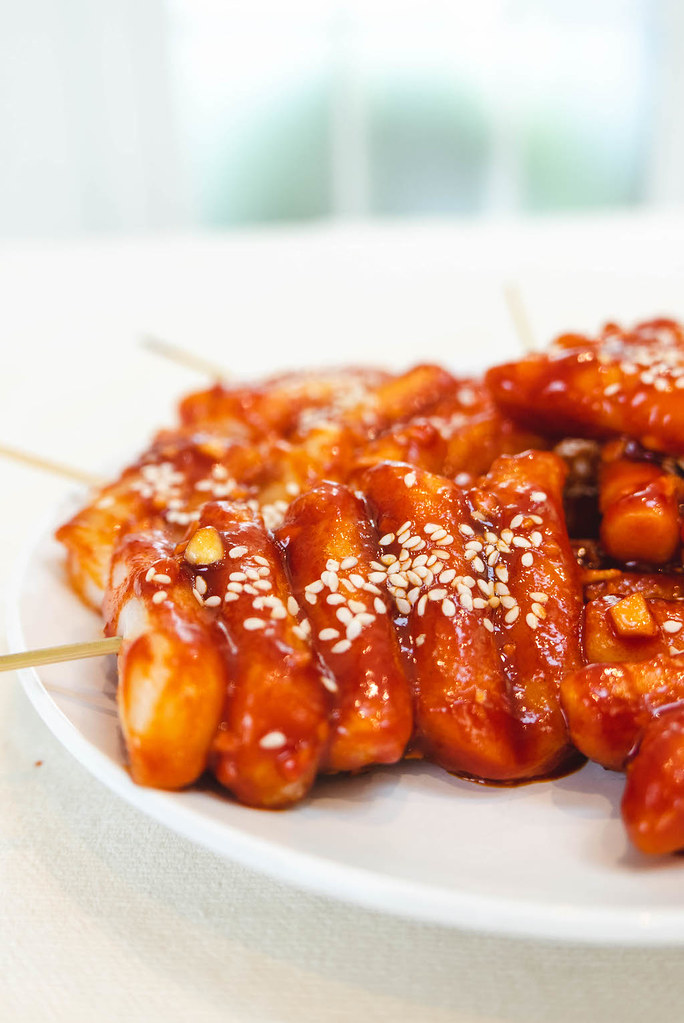
The other ingredients do not usually contain any major allergen. But, like always, check the ingredient labels before buying or cooking with them!
What Type of Oil Should I Use to Pan Fry or Grill?
I recommend using a type of oil with a high smoking point such as vegetable oil. Both olive oil and canola oil will work with this recipe! If you use the olive oil linked above, know that I am affiliated with the Hic Olive Oil Store. I love their oils!
How Do I Store the Leftovers?
If you have leftovers, you can easily store these in an airtight container in the refrigerator for a few days.
Later, you can eat these skewers cold if you do not want to heat them. Just know, they will have a bit of a harder texture. If you do not like the tteokkochi cold, you can microwave the them to make them less hard. Just know, when you microwave them, the crispy outside texture gets softer.
No matter what, these taste best hot or at room temperature right after you make them.

We Hope You Enjoy This Korean Tteokkochi Recipe!
We hope you enjoy trying this popular Korean street snack! If so, let us know in the comment section below. Also, we would love to hear about your favorite Korean street foods and snacks as well!
If you would like to read more about cooking, you can find further recipes on our blog. We listed some of our favorite Korean Carving A Journey recipes below! For reference, many of our recipes come from our blended Korean and Southern heritage.
Carving A Journey Food and Drink Recipes:
- Bibimmyeon (Spicy Korean Cold Noodles)
- Soju Caipirinha (A Korean Take on Brazil’s National Drink)
- Andong Jjimdak (Korean Braised Chicken)
- Korean Strawberry Milk Recipe
- Brown Sugar Iced Latte (Korean Burnt Sugar Latte); And
- Korean Banana Flavored Milk
If you have any questions or comments, you can also email us at [email protected].
And, finally, we would love to hear from you through our social media as well! You can follow us at @carvingajourney on Instagram, Twitter, Facebook, and Pinterest. Or, if you would like more articles like these, you can subscribe to our blog by joining our mailing list. We hope you enjoy trying our Korean tteokkochi recipe! Thank you so much for stopping by!
Carving A Journey is a participant in the Amazon Services LLC Associates Program, an affiliate advertising program designed to provide a means for sites to earn advertising fees by advertising and linking to Amazon.com. Although we may earn commissions for our endorsement, recommendation, testimonial, and/or link to any products or services from this website, these opinions are my own and I fully support these products.

